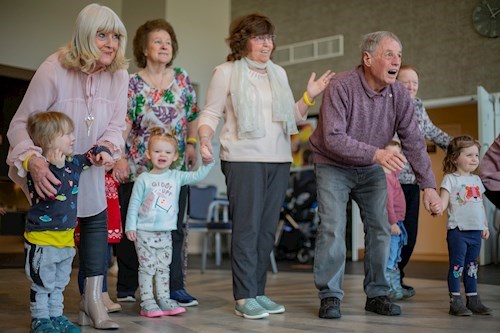A society that is living longer, writes Charlotte Millions of The Extra Care Trust, brings its own set of challenges, and demands that we adapt and become smarter… making the importance of intergenerational relationships ever more apparent.
Intergenerational living is one way in which this can be achieved: the United for All Ages think tank is even campaigning for 1,000 cross-generational sites to be opened by 2030 in the UK. But links are already being forged throughout the country between the generations. One such participant in intergenerational practice is the ExtraCare Charitable Trust, a leading not-for-profit developer of housing that supports older people in 16 retirement villages and four housing schemes.
At village locations, age integration programmes are frequently in action. Villages have links with local schools, youth groups and local communities, often since their opening. Volunteers of all ages are working in retirement communities: differing age groups step in to give their time at charity shops, and preschool groups visit locations weekly to read or play with residents.
Combining the idea of nurseries or pre-schools with retirement villages has already improved generational intelligence. Channel Four’s Old People’s Home For 4-Year-Olds filmed at ExtraCare’s Lark Hill Village over six months and revealed many integration benefits as relationships formed. Resident Ken, 91, who took part in the show felt it was life-changing, commenting: “It was an experiment to see if bringing the young and old together would bring benefits. We’ve proved the experiment works for both parties and it’s been a life changing programme.”
Socio-emotional outcomes
General findings into intergenerational relationships have reported that children in pre-school who are partnered with older volunteers show better socio-emotional outcomes such as increased tolerance of others, increased empathy, less judgement, and greater social acceptance [2]. Other US based studies also document improved vocabulary and language ability[3].
Mutually beneficial activities bring generational groups together, addressing social and community issues these programmes are built on the positive resources that young and old have to offer each other and to their communities. The mental and physical benefits can be plentiful and promote greater understanding, respect and support between social groups. Potential benefits that have been noted include decreased social isolation, improved quality of life and purpose in life, improved self-worth, self-esteem, empowerment, cognitive health, reduced falls and frailty, increased strength, balance, and walking. [4]
HomeFromHome, a unique childcare setting based in the West Midlands with a focus on building community and intergenerational activities visit ExtraCare’s Solihull Village twice a week. A group of up to ten children aged between 9 months and 4 years old visit. The group take part in a library session and children’s tennis with the residents. For ExtraCare resident Rob, 72, who has survived two brain haemorrhages and suffers from memory loss and dementia, the 60-minute sessions have proved life-enhancing.
“It’s smashing, it’s lovely, I call myself grandad, it’s amazing. Coming here and seeing what the children can do and understand from such an early age it’s unbelievable. It makes me happier for coming.”
Falls and frailty have also been noted to reduce by Home From Home staff and were observed in participants in Old People’s Home for 4 Year Olds. A team of geriatric specialists medically tested the impact the children had on the older group and the results demonstrated significant improvements in mood, movement and mobility of the older group. Margaret, 84 at the time of filming was a former nursery teacher, who had osteoarthritis in her spine, hands, and shoulders, both knees and a hip replaced but this didn’t stop her dancing with her walker when she took part in the experiment.
“I loved every minute. I really did,” she says. 102-year-old Sylvia, who was deemed frail at the start of the experiment, was no longer considered so at the end of the experiment. There was also the case of an ExtraCare resident who first attended intergenerational tennis sessions in a wheelchair, and by her third week was walking unaided across the hall bouncing a balloon on her tennis racket.
A sense of connectedness and community
It’s not just the youngest and eldest of society that benefits from the intergenerational cycle, older volunteers report less social isolation, more social support, a sense of connectedness and community[5]. With family units often becoming transient and multi-layered, and with distance from extended family increasing, the need for community cohesion and enriched relationships increases. A portion of the younger generation have absent grandparents, and older residents can be important figures for them from a generation that they may have minimal interaction with in day-to-day life. Using elder resident’s previous career skillsets during interactions can also increase feelings of self-worth and pride. Results also suggest better attitudes towards older people, less stereotyping and less anxiety about ageing.[6]
The Bringing Generations Together Report, The Care Inspectorate 2019 stated that: “It’s really important that both the younger and the older children have a better understanding of what it is like to be an older person. Older people can broaden their circle of friends and reconnect with the children they may not have seen for a couple of months which has a big impact on their health and wellbeing.”
As restrictions lift and humans make their way back to a physically integrated post-pandemic society, now more than ever it is up to us to realise the importance of human connection and to continue to create intergenerational sites that foster connection and healthy ageing, enhancing lives across the age spectrum.
[1] https://www.theguardian.com/society/2020/jan/14/connecting-elderly-care-with-local-communities
[2] Gilchrist, 2014, The Impact of Intergenerational Programs: Evidence for Expansion (Doctoral dissertation, Miami University); DeVore et al., 2016; Lux et al., 2020; George & Wagler, 2014.
[3] Heydon, 2017; et al., 2020; Femia et al., 2008
[4] https://generationsworkingtogether.org/case-studies/physical-activity-project-in-care-homes
[5] Ellis, S. (2004a). Generations in Action: Final Evaluation Report. Stoke-on-Trent: Beth Johnson Foundation.
[6] Drury et al, AgeUK
